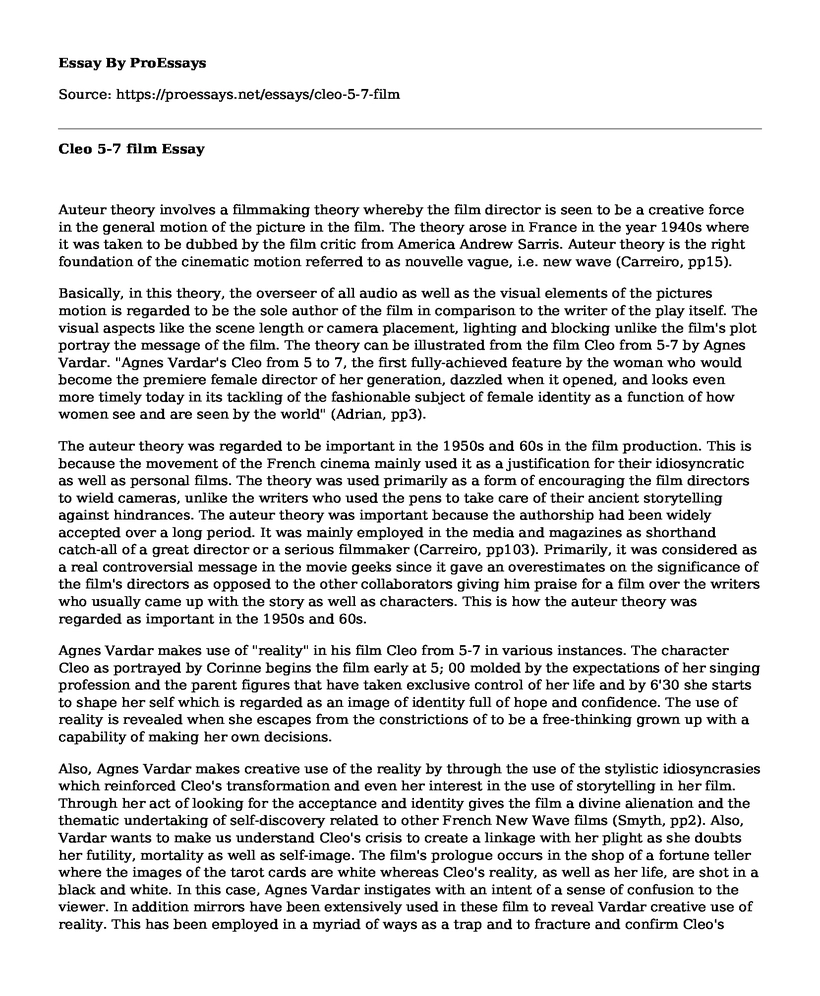Auteur theory involves a filmmaking theory whereby the film director is seen to be a creative force in the general motion of the picture in the film. The theory arose in France in the year 1940s where it was taken to be dubbed by the film critic from America Andrew Sarris. Auteur theory is the right foundation of the cinematic motion referred to as nouvelle vague, i.e. new wave (Carreiro, pp15).
Basically, in this theory, the overseer of all audio as well as the visual elements of the pictures motion is regarded to be the sole author of the film in comparison to the writer of the play itself. The visual aspects like the scene length or camera placement, lighting and blocking unlike the film's plot portray the message of the film. The theory can be illustrated from the film Cleo from 5-7 by Agnes Vardar. "Agnes Vardar's Cleo from 5 to 7, the first fully-achieved feature by the woman who would become the premiere female director of her generation, dazzled when it opened, and looks even more timely today in its tackling of the fashionable subject of female identity as a function of how women see and are seen by the world" (Adrian, pp3).
The auteur theory was regarded to be important in the 1950s and 60s in the film production. This is because the movement of the French cinema mainly used it as a justification for their idiosyncratic as well as personal films. The theory was used primarily as a form of encouraging the film directors to wield cameras, unlike the writers who used the pens to take care of their ancient storytelling against hindrances. The auteur theory was important because the authorship had been widely accepted over a long period. It was mainly employed in the media and magazines as shorthand catch-all of a great director or a serious filmmaker (Carreiro, pp103). Primarily, it was considered as a real controversial message in the movie geeks since it gave an overestimates on the significance of the film's directors as opposed to the other collaborators giving him praise for a film over the writers who usually came up with the story as well as characters. This is how the auteur theory was regarded as important in the 1950s and 60s.
Agnes Vardar makes use of "reality" in his film Cleo from 5-7 in various instances. The character Cleo as portrayed by Corinne begins the film early at 5; 00 molded by the expectations of her singing profession and the parent figures that have taken exclusive control of her life and by 6'30 she starts to shape her self which is regarded as an image of identity full of hope and confidence. The use of reality is revealed when she escapes from the constrictions of to be a free-thinking grown up with a capability of making her own decisions.
Also, Agnes Vardar makes creative use of the reality by through the use of the stylistic idiosyncrasies which reinforced Cleo's transformation and even her interest in the use of storytelling in her film. Through her act of looking for the acceptance and identity gives the film a divine alienation and the thematic undertaking of self-discovery related to other French New Wave films (Smyth, pp2). Also, Vardar wants to make us understand Cleo's crisis to create a linkage with her plight as she doubts her futility, mortality as well as self-image. The film's prologue occurs in the shop of a fortune teller where the images of the tarot cards are white whereas Cleo's reality, as well as her life, are shot in a black and white. In this case, Agnes Vardar instigates with an intent of a sense of confusion to the viewer. In addition mirrors have been extensively used in these film to reveal Vardar creative use of reality. This has been employed in a myriad of ways as a trap and to fracture and confirm Cleo's identity (Smyth, pp2). All these instances used by Vardar in the film is to bring in the issue of identity in a more divine way.
Works Cited
Carreiro, Alexis Leigh. Script-to-screen: film editing and collaborative authorship during the Hollywood renaissance. The University of Texas at Austin, 2010.
Smyth, Sarah Louise. "Feminist film theory and 'Cleo from 5 to 7'." (2018): 1-3.
Adrian, Martin. "Passionate Time." (2008): 1-8
Cite this page
Cleo 5-7 film. (2022, Nov 21). Retrieved from https://proessays.net/essays/cleo-5-7-film
If you are the original author of this essay and no longer wish to have it published on the ProEssays website, please click below to request its removal:
- Jail Offender Issues Reentry to Society - Essay Sample
- Paper Example on Interviews: Gather Info for Cybercrime Case, Analyze for Perpetrator
- Child Development: Genes, Environment, and Play - Essay Sample
- Essay Sample on Bullying in the Workplace: Recognizing the Subtle Signs
- Daniel Boone: Offender, Prisoner, HIV-Infected Pedophile - Case Study
- Essay Sample on NC School Report Card: Essential for Parents, Educators & Researchers
- Free Essay Sample: Interpreting Verbal Reasoning Test Scores







